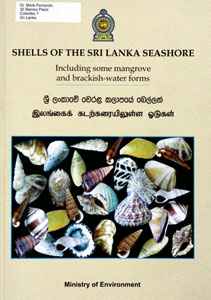Sri Lanka is surrounded by the sea and is probably home to many thousands of molluscs. The exact number awaits future taxonomic work. Kirtisinghe (1978) published his book with illustrations of 450 such individuals and suggests that the actual number could be around 1500. This uncertainty of the number is due to the lack of persons studying the molluscan fauna in Sri Lanka.
Dr. Malik Fernando, a professional medical doctor and a diver has been interested in the natural history of the ocean for many years. He is thus not a fully fledged “malacologist” (those who study the whole animal, including the anatomy of the body) or a “conchologist” (those who study shells of molluscs), yet he is the best person who is capable of identifying our sea shells. In the absence of scientific study (Malacology) it has become difficult to specifically identify and document the number of species in the country. Thus the numerous publications of the region have been consulted by Dr. Malik in the compilation of this publication.
 |
This book contains descriptions of 81 specimens. A very small number compared to what is given in Kirtisinghe. But that is because the publication is limited to “shells of the seashore” and to the intertidal habitats (“includes those forms that live on that part of the coast that is periodically covered and uncovered by waves and the rising and falling of tides”).
Further it “excludes empty shells found on beaches that were occupied by animals living in totally submerged (subtidal) habitats”. Some shells of shallow or totally submerged shallow waters, and in the supratidal habitats have been included. It also includes those in mangrove and wading habitats close to the coast line. In the author’s words “ This book does not describe all the intertidal, mangrove and lagoon species in Sri Lanka.”
An entire section “scope” - has described what is in and what is not in the book. It thus provides a very good base for using the book with limits. The study has also focused on the habitat at Mount Lavinia as “much of the studies that led to this book were carried out at Mount Lavinia” at the beach near the hotel.
It thus provides a good background to what nature can reveal in a good study of a small area of the coast. It also gives us an idea of what could be available around the country if an extensive study is undertaken. A definite need to document the rich biodiversity of the country. But to any beginner this approach in the book provides confidence to commence, without getting lost in immense diversity.
The text is simple and easy to read. The photo-plates are very clear and make identification easy. I will definitely recommend it to any person interested in starting an interest in molluscs.
The author’s attempt to make it available beyond the English speaking audience is commendable, and this in two languages – Sinhala and Tamil. However, the format does not help in the process. One has to accept first that this “Natural History” knowledge evolved in the English language. The technical terms come from the science that comes to us through English and Latin.
They thus do not have equivalent Sinhala or Tamil names in most situations. A completely Sinhala or Tamil nomenclature would thus be difficult, yet it is needed. The general approach would be to seek this in the literature and from the vernacular speakers in the field. This attempt is visible with some terms in the text. There are, however, serious inconsistencies, and in some places I would say wrong interpretations that have led to wrong words. These comments are of course with respect to Sinhala. The absence of a glossary in Sinhala is a serious lapse, especially in this situation of introducing a new area of study to interested parties. Terms in Figures 1 and 2 are not provided in Sinhala and Tamil.
The lay-out of English followed immediately by Sinhala and Tamil breaks the trend of concentration; it would have been better if they were in separate blocks. That could not have adversely affected the objective – unless, perhaps, some legal requirement was there?
Despite these faults it is still a starter for Sinhala readers and I am sure it is the same for Tamil readers too. Books of this nature are needed for the school system. If the format and the weakness of the lack of a proper glossary of terms in Sinhala are addressed, it should become an essential text for all nature loving persons and the school system to have. Malik is a naturalist with an intimate knowledge of the ocean fauna close to our shores. He should be encouraged to pen more publications with this type of information so that more students and the public can appreciate and conserve our rich biodiversity.
(The reviewer is a Professor of Environment Science) |


